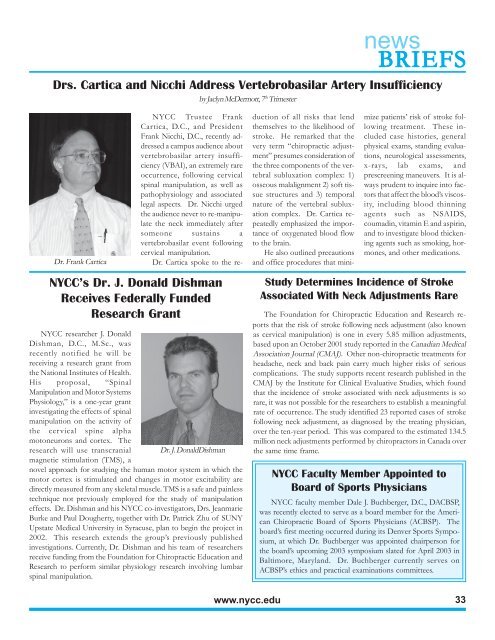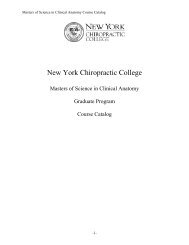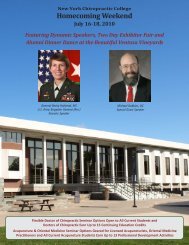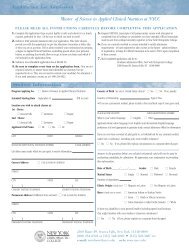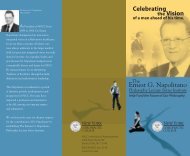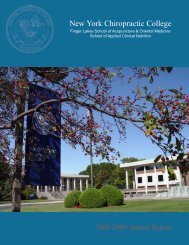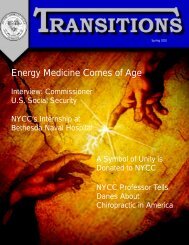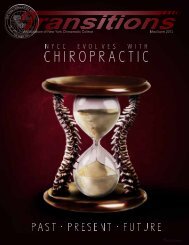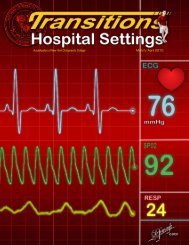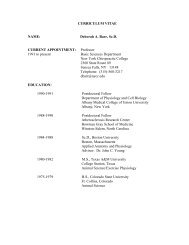2502 NYCC TRANS FINAL2 - New York Chiropractic College
2502 NYCC TRANS FINAL2 - New York Chiropractic College
2502 NYCC TRANS FINAL2 - New York Chiropractic College
You also want an ePaper? Increase the reach of your titles
YUMPU automatically turns print PDFs into web optimized ePapers that Google loves.
news<br />
BRIEFS<br />
Drs. Cartica and Nicchi Address Vertebrobasilar Artery Insufficiency<br />
by Jaclyn McDermott, 7 th Trimester<br />
Dr. Frank Cartica<br />
<strong>NYCC</strong>’s Dr. J. Donald Dishman<br />
Receives Federally Funded<br />
Research Grant<br />
<strong>NYCC</strong> researcher J. Donald<br />
Dishman, D.C., M.Sc., was<br />
recently notified he will be<br />
receiving a research grant from<br />
the National Institutes of Health.<br />
His proposal, “Spinal<br />
Manipulation and Motor Systems<br />
Physiology,” is a one-year grant<br />
investigating the effects of spinal<br />
manipulation on the activity of<br />
the cervical spine alpha<br />
motoneurons and cortex. The<br />
research will use transcranial Dr. J. DonaldDishman<br />
magnetic stimulation (TMS), a<br />
novel approach for studying the human motor system in which the<br />
motor cortex is stimulated and changes in motor excitability are<br />
directly measured from any skeletal muscle. TMS is a safe and painless<br />
technique not previously employed for the study of manipulation<br />
effects. Dr. Dishman and his <strong>NYCC</strong> co-investigators, Drs. Jeanmarie<br />
Burke and Paul Dougherty, together with Dr. Patrick Zhu of SUNY<br />
Upstate Medical University in Syracuse, plan to begin the project in<br />
2002. This research extends the group’s previously published<br />
investigations. Currently, Dr. Dishman and his team of researchers<br />
receive funding from the Foundation for <strong>Chiropractic</strong> Education and<br />
Research to perform similar physiology research involving lumbar<br />
spinal manipulation.<br />
<strong>NYCC</strong> Trustee Frank<br />
Cartica, D.C., and President<br />
Frank Nicchi, D.C., recently addressed<br />
a campus audience about<br />
vertebrobasilar artery insufficiency<br />
(VBAI), an extremely rare<br />
occurrence, following cervical<br />
spinal manipulation, as well as<br />
pathophysiology and associated<br />
legal aspects. Dr. Nicchi urged<br />
the audience never to re-manipulate<br />
the neck immediately after<br />
someone sustains a<br />
vertebrobasilar event following<br />
cervical manipulation.<br />
Dr. Cartica spoke to the reduction<br />
of all risks that lend<br />
themselves to the likelihood of<br />
stroke. He remarked that the<br />
very term “chiropractic adjustment”<br />
presumes consideration of<br />
the three components of the vertebral<br />
subluxation complex: 1)<br />
osseous malalignment 2) soft tissue<br />
structures and 3) temporal<br />
nature of the vertebral subluxation<br />
complex. Dr. Cartica repeatedly<br />
emphasized the importance<br />
of oxygenated blood flow<br />
to the brain.<br />
He also outlined precautions<br />
and office procedures that minimize<br />
patients’ risk of stroke following<br />
treatment. These included<br />
case histories, general<br />
physical exams, standing evaluations,<br />
neurological assessments,<br />
x-rays, lab exams, and<br />
prescreening maneuvers. It is always<br />
prudent to inquire into factors<br />
that affect the blood’s viscosity,<br />
including blood thinning<br />
agents such as NSAIDS,<br />
coumadin, vitamin E and aspirin,<br />
and to investigate blood thickening<br />
agents such as smoking, hormones,<br />
and other medications.<br />
Study Determines Incidence of Stroke<br />
Associated With Neck Adjustments Rare<br />
The Foundation for <strong>Chiropractic</strong> Education and Research reports<br />
that the risk of stroke following neck adjustment (also known<br />
as cervical manipulation) is one in every 5.85 million adjustments,<br />
based upon an October 2001 study reported in the Canadian Medical<br />
Association Journal (CMAJ). Other non-chiropractic treatments for<br />
headache, neck and back pain carry much higher risks of serious<br />
complications. The study supports recent research published in the<br />
CMAJ by the Institute for Clinical Evaluative Studies, which found<br />
that the incidence of stroke associated with neck adjustments is so<br />
rare, it was not possible for the researchers to establish a meaningful<br />
rate of occurrence. The study identified 23 reported cases of stroke<br />
following neck adjustment, as diagnosed by the treating physician,<br />
over the ten-year period. This was compared to the estimated 134.5<br />
million neck adjustments performed by chiropractors in Canada over<br />
the same time frame.<br />
<strong>NYCC</strong> Faculty Member Appointed to<br />
Board of Sports Physicians<br />
<strong>NYCC</strong> faculty member Dale J. Buchberger, D.C., DACBSP,<br />
was recently elected to serve as a board member for the American<br />
<strong>Chiropractic</strong> Board of Sports Physicians (ACBSP). The<br />
board’s first meeting occurred during its Denver Sports Symposium,<br />
at which Dr. Buchberger was appointed chairperson for<br />
the board’s upcoming 2003 symposium slated for April 2003 in<br />
Baltimore, Maryland. Dr. Buchberger currently serves on<br />
ACBSP’s ethics and practical examinations committees.<br />
www.nycc.edu<br />
33


